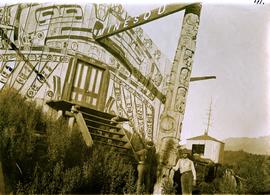The entire body of Reverends Collison’s and Large’s Archives are of great research significance to researchers of early missionary history of British Columbia, as well as to researchers of First Nations history and the impacts of missionary expeditions on First Nations communities in Northern BC. 
Image: 2009.7.1.104 - Chief's lodge and totem, Nass River, BC.
 Archdeacon W. H. Collison fonds - 2009.7
Archdeacon W. H. Collison fonds - 2009.7
The Collison fonds consists of records documenting his life and work with North Coastal First Nations communities in Northern British Columbia. William Henry Collison (1847-1922) of County Armagh, Northern Ireland was educated at the Church of Ireland Training College in Dublin; in 1872 he read of the Church Missionary Society's need for recruits and entered the Church Missionary College. The CMS decided that his qualifications made him a suitable assistant for William Duncan, the lay missionary in charge of the North Pacific mission, centred at Metlakatla, B.C. Along with his wife Marion Goodwin, a deaconess and trained nurse, they reached Metlakatla in late 1873. As well as preaching, his duties included visiting and teaching. He became interested in the Haida peoples when a group from Masset visited Fort Simpson (Lax Kw'alaams) in 1874 & 1875. During these visits Collison began to evangelize Chief Seegay and obtained permission to open a mission there. After the Collisons' move to Masset, he expanded his knowledge of Haida, eventually translating portions of the Bible and the Book of Common Prayer and composing hymns in this language. In 1878 he was ordained deacon and priest and assigned the "spiritual charge" of Metlakatla, Kincolith, and Haida Gwaii. In 1891 Collison was unanimously selected as the new diocese of Caledonia's first archdeacon.
 In 1893 Collison introduced a native branch of the Church Army, a strongly evangelical Anglican organization that emphasized enthusiastic worship, and promoted native leadership within the church-sponsored society. This Army was characterized by its brass band which assisted in the very musical, evangelistic mission services. Marion Collison's role was equally significant as she taught European domestic skills to the native women, and as nurse she helped avert a smallpox epidemic. W.H. Collison was the longest serving Church Missionary College (CMS) missionary in the North British Columbia Mission and was the only remaining missionary funded directly by the CMS. Collison’s interaction with the First Nations peoples to which he ministered was complex. He respected the converts, became fluent in Tsimshian, Haida, and Nisga'a, and was sensitive to the importance of the clan system. However, he fiercely opposed potlatching and traditional native medicine, and encouraged the Nisga'a at Kincolith to accept the Indian Advancement Act of 1884, which replaced traditional hierarchies of power with a system of elected chiefs and band councils supervised by an Indian agent.
In 1893 Collison introduced a native branch of the Church Army, a strongly evangelical Anglican organization that emphasized enthusiastic worship, and promoted native leadership within the church-sponsored society. This Army was characterized by its brass band which assisted in the very musical, evangelistic mission services. Marion Collison's role was equally significant as she taught European domestic skills to the native women, and as nurse she helped avert a smallpox epidemic. W.H. Collison was the longest serving Church Missionary College (CMS) missionary in the North British Columbia Mission and was the only remaining missionary funded directly by the CMS. Collison’s interaction with the First Nations peoples to which he ministered was complex. He respected the converts, became fluent in Tsimshian, Haida, and Nisga'a, and was sensitive to the importance of the clan system. However, he fiercely opposed potlatching and traditional native medicine, and encouraged the Nisga'a at Kincolith to accept the Indian Advancement Act of 1884, which replaced traditional hierarchies of power with a system of elected chiefs and band councils supervised by an Indian agent.
Physical description: 76 cm textual records; 315 photographs, 4 maps
 Record types include: manuscripts, sermon notes, correspondence, oral history summaries, monographs, cartographic items, photographs and postcards. Also an unpublished manuscript authored by W.H. Collison of the retelling of First Nations stories and his speech booklet containing notes of traditions and events he witnessed along the North West Coast of B.C. Photographs depict Collison family members, North Coastal First Nations communities, means of transportation along North Coastal British Columbia, and various church structures and religious events.
Record types include: manuscripts, sermon notes, correspondence, oral history summaries, monographs, cartographic items, photographs and postcards. Also an unpublished manuscript authored by W.H. Collison of the retelling of First Nations stories and his speech booklet containing notes of traditions and events he witnessed along the North West Coast of B.C. Photographs depict Collison family members, North Coastal First Nations communities, means of transportation along North Coastal British Columbia, and various church structures and religious events.
Restrictions on access: Some restrictions are in effect, see individual descriptions for accessibility. Contact the archives for access to restricted records.
Images (top to bottom):
 In the Wake of the War Canoe
by
William H. Collison; Charles Lillard (Editor)
In the Wake of the War Canoe
by
William H. Collison; Charles Lillard (Editor)
 Reverend R.W. Large Photographic Collection - 2004.2
Reverend R.W. Large Photographic Collection - 2004.2
Large was a Methodist minister and doctor on the Northwest Coast of BC from 1898-1920. He worked at the Methodist hospital and mission in Bella Bella until 1906. He then went on to work at Rivers Inlet Hospital in Ocean Falls until he moved to Port Simpson in 1910, where he worked until his death. Reverend Large was the only known observer to document the community of Bella Bella from 1898 to 1906. The Collection consists of 130+ photographs depicting Northwest Coast communities including Bella Bella, Rivers Inlet, Port Simpson, and Prince Rupert c.1900-c.1920. The collection includes postcard images of ships on the North Coast.
Note: Descriptions under cultural review. Contact archives for details.
Image: 2004.2.1.64 - Kitwanga
